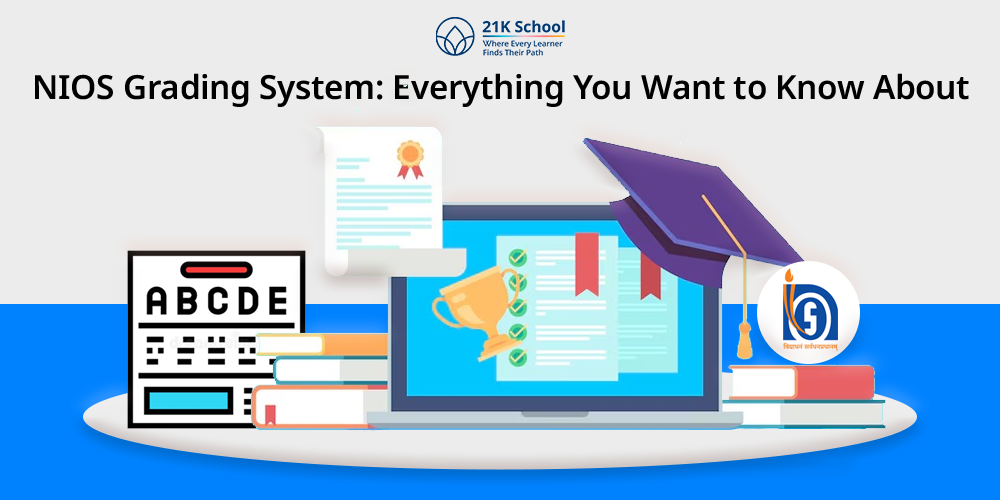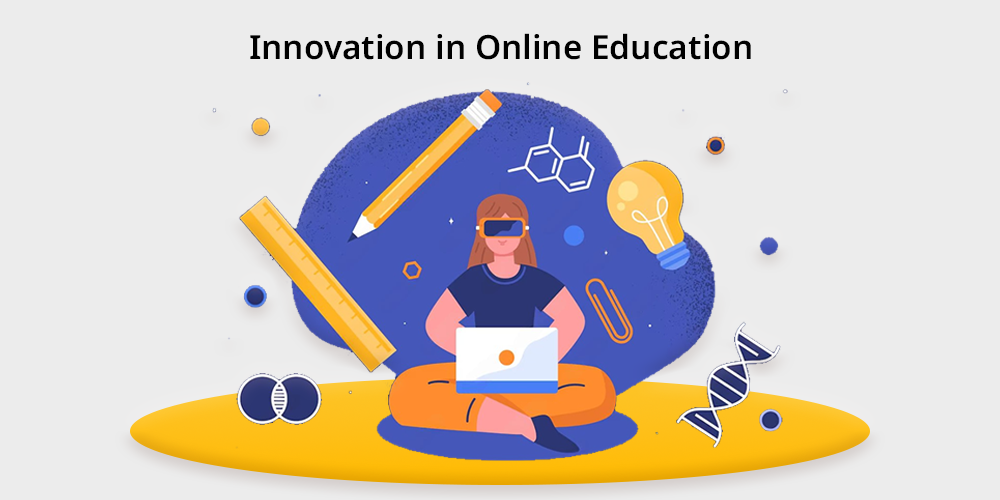
With the advancement of technology, innovation in online education has also gone through a significant change. Distance education and remote learning have undergone various changes. The COVID-19 pandemic has shifted traditional education into online learning.
The educational change has brought the attention of many students to online study because of its flexibility and easy accessibility.
But continuing online courses is not only the future aspect of distance learning. Instead, it is a continuous process that helps in development and trends which will revolutionize the remote learning opportunities.
Online education has changed a lot after the pandemic, as in today’s world, education has become more engaging, interactive and personalized.
This allows kids to develop cognitive skills and enhance critical thinking abilities. Through technology, students will develop more interest towards the learning process.
Contents
- What is Innovation in Education?
- Key Trends of Innovation in Online Education
- Importance of Innovation in Online Education
- Strategies for Sustaining Innovation in Online Education
- 1. Enhance Supportive Leadership:
- 2. Faculty Encouragement:
- 3. Adoption of Technologies:
- 4. Develop Collaborative Environment:
- 5. Implementation of Pedagogies:
- 6. Develop a Feedback Strategy:
- 7. Build an Innovative Ecosystem:
- 8. Leverage Data and Analytics:
- 9. Overcome Resistance to Adapt:
- 10. Risk Taking Initiative:
- 11. Motivation:
- 12. Support from Stakeholders:
- Challenges of Innovation in Online Education
- Ways to Achieve Innovation in Online Education
- Examples of Innovation in Online Education
- Conclusion
What is Innovation in Education?

Innovation in education can be defined as an evolution of education over a period of time. Innovation in online education is the process of implementing new technology and methods to enhance the learning outcomes.
Innovation in learning contains new technical methods, and techniques such as the implementation of AI in education, the use of AR/VR, gamification methods, micro learning, mobile learning and so on.
Innovation in education makes learning more engaging and promotes active learning methods. This also helps in boosting the teaching and learning process and allows kids to adapt to learning opportunities.
Innovation in education uses effective techniques such as quizzes, games, real-time feedback and assessments. This allows student engagement and helps in identifying the problems and enhancing digital literacy.
Key Trends of Innovation in Online Education

With time, education has gone through various innovations, and most changes have been seen in online education. Digital literacy has innovated through implementing various types and methods such as AI, AR, VR, Gamification and so on.
These trends are new and shaping traditional education into an engaging one. Here are the current key trends of innovation in online learning mentioned below.
1. Artificial Intelligence (AI):

AI is a computer system that allows computers to think like humans and use computer intelligence to solve any problems.
AI has changed the system and teaching-learning process by implementing personalized and adaptive learning opportunities for every student.
AI is also helping students through online education with their assignments, teaching, problem solving and so on. It acts as a personal guide for students.
Even teachers are using AI to record their lectures and help in assessing the weaknesses and performance of their students.
2. Augmented Reality and Virtual Reality:

AR and VR are a new generation of video simulation to enhance the experience of online education. That provides real-life videos to grasp the concepts more easily. These technologies help in making tough concepts easy through video simulation.
VR and AR provide practical experience through video simulation. This allows kids to engage in class activities and understand complex topics more easily.
Even AR and VR are also used in higher education to help children gain practical insights.
3. Microlearning:

Microlearning is a new, innovative method of teaching contexts. In this method, concepts are delivered into smaller parts or using short terms to teach difficult topics.
Microlearning facilitates students’ understanding by dividing complex subjects into simpler ones.
This method is ideal for students who have hectic schedules and short attention spans. This method is also very helpful to make learning more efficient, especially for remote and online learning.
4. Gamification:

Gamification is an interactive method of education. With innovation in online education, gamification has taken a new initiative to enhance the study process of students. Gamification allows kids to learn complex topics through exciting methods.
Gamification includes games, badges, points and bonuses. This initiative makes subjects more engaging and makes kids more motivated. Through gamification, learning becomes more fun and enjoyable.
5. Mobile Learning:

Mobile learning is the most used e-learning method by the largest number of children. Mobile learning, which is also known as m-learning(mobile learning), includes the use of smartphones and tablets for educational purposes.
It provides access to resources at any time and from any location while encouraging participation of students from every background.
There are various e-learning platforms that provide educational content over mobile phones, such as 21K school, Byjus, PW, etc.
Importance of Innovation in Online Education

Innovation in education is very important because it not only provides holistic education but also helps in enhancing the formats and styles.
Innovation in online education enhances learning outcomes, boosts student engagement, and promotes holistic development, as well as helps in promoting critical thinking, creativity and adaptability for students.
Below, you can check why innovation in online learning is essential
- Real Time Feedback: One of the effective features of innovation in online education is that it provides real-time feedback. Through online classes, teachers can achieve real-time feedback from students.
In video classes, students can ask questions and reply to the questions through software tools. This allows teachers to connect with students more easily and develop collaborative learning among them.
- Enhance Student Engagement: Innovation in online education focuses on using interactive methods of teaching, which allow students to become more engaged.
Dynamic content, gamification methods, and flexible processes enable them to enhance their engagement and convert a boring class into a fun one.
- Easy Access to Educational Resources: Technology makes it simple for students to locate resources and obtain high-quality instruction.
With the help of technology, students can easily access study materials, e-books, sample papers and past test questions online. This aids them in gaining appropriate knowledge and equal access to educational opportunities.
- Enhance Problem Solving Abilities: Innovation in online education uses effective methods known for boosting critical thinking skills and enhancing problem-solving skills.
Young kids are curious, and innovative approaches are useful for students to inspire them to take real-world challenges and create solutions to the problem.
- Life Oriented Learning: Promoting lifelong learning is one of the biggest benefits of technology in education. Online education makes learning more accessible and promotes self-directed study outside of the conventional classroom. Permit both adults and children to participate more actively in class.
Strategies for Sustaining Innovation in Online Education

Online education has expanded access to a larger population. Through online adaptation, institutions can offer engaging, individualized, and adaptable learning experiences that satisfy the needs of every student.
Innovation in education is essential for meeting the changing demands of employers, society, and students. As the world’s technology advances, educational institutions need to embrace new pedagogies and technologies to bring positive changes.
Here is the strategy that allows for sustaining innovation in online education.
1. Enhance Supportive Leadership:

Leadership is essential in promoting innovation. In order to support innovative initiatives, leaders must encourage innovation and supply the required funds and resources.
This initiative inspires faculty and staff to keep coming up with new ideas.
Innovation in education also promotes thought leadership among individuals. Through innovation in education, students can understand the educational process and the importance of leadership.
2. Faculty Encouragement:

Encouraging faculty is very much essential in developing innovative education.
As teachers, staff, mentors and faculty members are the first people who can bring innovation in online education and adapt to the changes.
This can be achieved if faculty members are trained by institutions on new pedagogies, technologies, and teaching methods.
Additionally, educational institutions can promote innovation in education through establishing labs where faculty members can test out new technologies and teaching strategies.
3. Adoption of Technologies:

Technology plays an integral role in developing it more effectively and collaborative.
Technology is evolving rapidly, and it is essential to adapt to the changes. Such as the implementation of AI, AR, VR, Chatbot, Video simulation and so on.
Technologies can be adopted if schools and educational institutions spend money on virtual reality and augmented reality technology to develop immersive environments that help students easily grasp difficult concepts.
4. Develop Collaborative Environment:
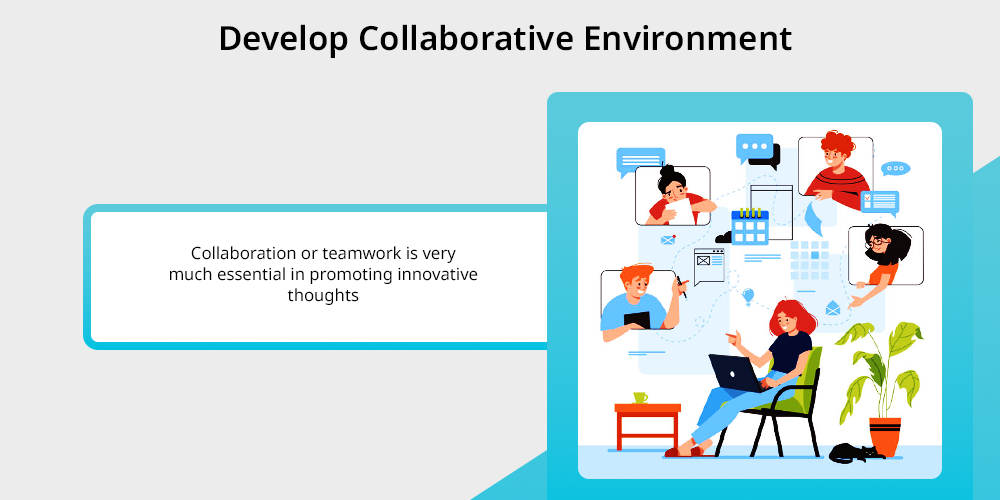
Collaboration or teamwork is very much essential in promoting innovative thoughts.
Collaboration among students, teachers, governments and staff members allows for sharing ideas, concepts, thoughts and knowledge, which helps in taking initiative steps to promote innovation in education.
Collaboration also supports building a community, which allows for developing initiative steps to enhance innovation in online learning and developing effective strategies to make it more impactful.
5. Implementation of Pedagogies:

An effective pedagogy is very necessary to teach students easily. Pedagogies must be designed in such a way that they deal with students’ pedagogies.
Implementation of new pedagogies helps in developing innovation in online learning.
By implementing practical methods and curriculum and converting offline education into online education, students will find it more engaging and easier. This initiative will help in promoting online innovation in education.
6. Develop a Feedback Strategy:

A feedback strategy is very important for understanding the needs and development areas.
In order to improve the quality of online education, educational institutions can use a feedback strategy to find areas that need improvement and make the required changes.
Feedback helps in demonstrating the ideas to stakeholders, whether it is appropriate or not. Through this strategy, innovation in online study can be achieved.
7. Build an Innovative Ecosystem:

Innovation in education is an ongoing process, and it adapts according to need. Institutions must develop procedures and frameworks that encourage ongoing innovation in order to establish a sustainable development initiative.
This allows for enhancing the outcomes for innovation in education and allows kids to engage in active education.
Teachers can also create an innovation ecosystem by developing a mechanism for the education system to allocate all the resources.
8. Leverage Data and Analytics:

Data and analysis are very important to understand the learning gaps and improvement areas. Through leveraging data and analytics, one can understand the impact of education in positive aspects.
This also helps educational institutes to develop innovative strategies for evolving the education sector.
With the help of innovative strategies, teachers can understand the necessary adjustments for implementing innovation in online education.
9. Overcome Resistance to Adapt:

Technology in education plays an important role in innovation in online education. However, many individuals are against online education or changes, as according to them, it will only hamper the education process and create insecurity in future.
Even teachers and students sometimes resist online education because they are accustomed to the traditional method only. For this reason, they are resistant to adopting innovation in learning.
This problem can be overcome if Institutions address the concerns and explain the advantages of innovation in order to overcome resistance to change.
10. Risk Taking Initiative:

Any new technology or changes have possible chances of risks. Innovation always has risks, as this is a continuous process and adapting the changes according to the requirements.
Fostering innovation in online education requires creating a culture that embraces taking risks and views failure as an opportunity for growth.
Institutes can boost risk-taking initiative by creating a safe space, where participants can experiment with new ideas and techniques without any fear of failure.
11. Motivation:

Sometimes a lack of motivation hinders the innovative in online education. It is essential for institutions and other educational authorities to keep things motivated and encourage collective action.
By encouraging every participant, it becomes possible to enhance the active outcomes of the innovation in it allows them to enhance their learning outcomes.
12. Support from Stakeholders:

Stakeholders play an important role in boosting innovation in online education. Institutions can use innovative methods to show the educational standards to gain support from Stakeholders.
Institutions can also engage stakeholders in the innovation process by asking for their opinions and suggestions, which will help in developing innovative methods for new education.
Challenges of Innovation in Online Education

Innovation in Online study is very much crucial to meet the adaptive changes of the 21st century. Innovation in technology helps in making it more personalized and interactive.
This allows kids to engage in more understanding sessions and allows them to grasp the concepts more effectively. However, there is a wide range of challenges for innovation in online learning.
- Lack of Proper Curriculum: Innovation in online study still faces hindrance in the course curriculum. Even with the technical changes, the institutes and online platforms have to use the old curriculum that mainly focuses on regular education.
Due to hindrances, it can be difficult to create an online curriculum that effectively conveys complex information and develops engaging content.
- Technical Gap: The technological gap is a huge challenge in implementing new innovations in education. Due to various issues such as a lack of technical knowledge, technical issues, internet connectivity and poor technological distribution cause hindrances in achieving innovation in education.
Some educators and students might not have the requisite abilities to use online learning platforms and technologies efficiently, which also causes trouble.
- Lack of Interaction and Motivation: In an online setting, lack of motivation and social interaction becomes a major challenge in taking initiative steps.
Less social interaction and a lack of face-to-face interaction with peers and teachers can cause the feeling of isolation among students. Even online environments sometimes make it difficult for students to remain motivated and concentrated.
- Lack of Equal Accessibility: One of the major reasons that hindered the innovation in online education is the lack of equal access to quality education for every student. Due to financial issues, technical issues, and remote issues, the unavailability of education has become a problem among many children.
Equality in online study depends on guaranteeing that every student has equal access to technology and a positive environment.
- Lack of Teacher Training: Due to a lack of teacher training, it becomes a challenge to adapt to new innovative learning methods. Many teachers find it tough to adapt to online learning and are resistant to it.
To adapt online teaching it is essential for teachers to get sufficient training and assistance. This will allow them to create a well-rounded learning environment.
Ways to Achieve Innovation in Online Education

Innovation in online study is very essential in leveraging quality and sustainable education. That not only helps students to engage in online learning but also helps them to achieve future success.
Innovation in online education can be achieved by implementing various technological aspects such as AI, gamification, and so on. Here are the ways through which you can achieve innovation in online study.
1. Implementation of AI in Learning:
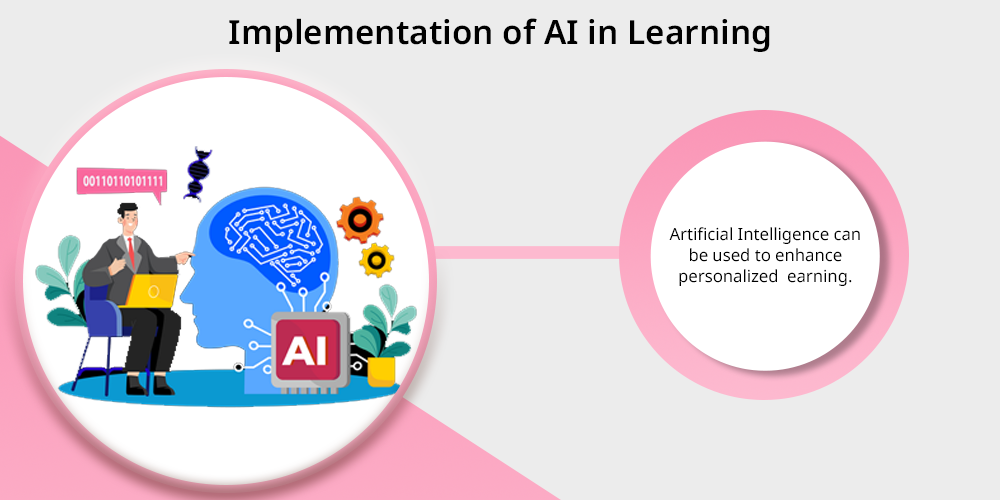
Artificial Intelligence can be used to enhance personalized learning. This is an initiative that focuses on the learning style of students. Every student has their own style of adaptation and speed.
By implementing AI in education, students can adapt and understand their concepts according to their comfort and speed. AI also helps teachers to develop course content according to the needs of every student.
2. Real Time Engagement:

A real-time interface is essential for promoting better academic performance. Various e-learning platforms are using real-time video interface that allows kids to engage in the classroom.
These can be achieved through incorporating strategies such as quizzes, online polls, puzzles and so on. Many virtual platforms, such as 21K school, uses interactive features to infuse regular classrooms with energy and promote engagement.
3. Social Media Community:

In today’s modern world, social media is a powerful tool to share messages and innovations.
Social media can be used to make online communities, and social media communities are one of the effective ways to share ideas, concepts, thoughts and so on.
Social media platforms can be used to promote collaboration and a sense of community among students.
By encouraging students to use the channels they feel most comfortable using to lead discussions in online communities or can share projects with each other
4. Developing Flipped Classroom:

The flipped classroom is an incredible way to enhance the teaching and learning process. In a flipped classroom, students attend class at home in an online mode and complete their tasks at school.
Through this model, students learn concepts through recorded videos or live classes at home. The flipped classroom helps students to learn independently and allows them to work on their own.
5. Interactive Video Lecture:

By implementing interactive video lectures, students will get more engaged with the classroom.
Using interactive tools and resources such as quizzes, polls, podcasts, and other elements allows students to be embedded in the video. These also enable a new initiative for implementing innovation in online study.
Examples of Innovation in Online Education
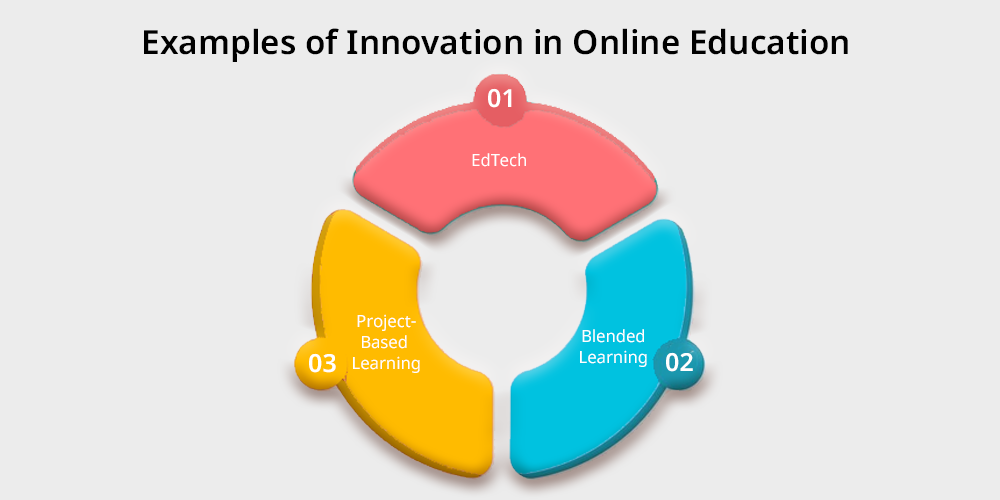
Innovation in education is the methods or changes appeared over time in education.
Innovation in education has various forms and techniques that have changed the shape of regular study. Below you can see an example of innovation in online study.
1. EdTech:
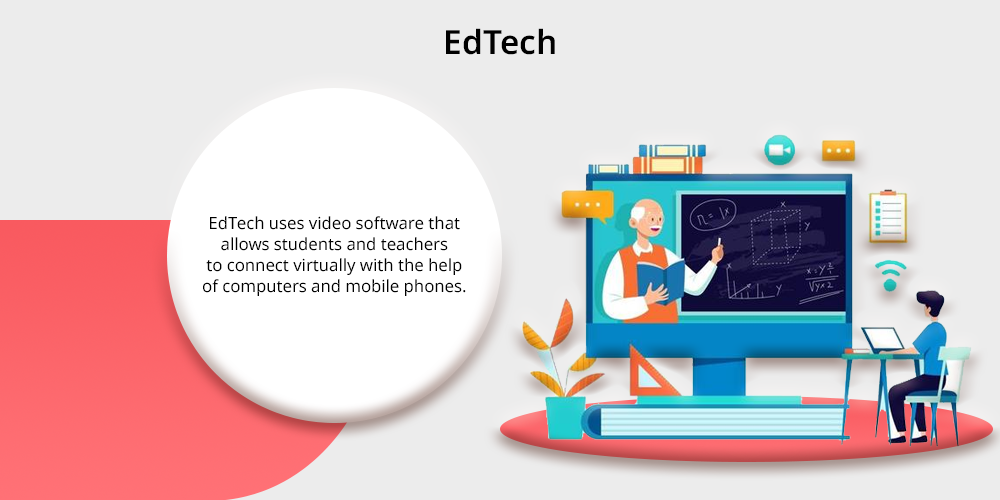
EdTech or educational technology is the new age learning initiative to provide educations to students with new age learning methods.
EdTech uses video software that allows students and teachers to connect virtually with the help of computers and mobile phones.
There are various EdTech platforms such as 21K school, K8 school, Spruha virtual school, and so on. These platforms use interactive methods to enhance the learning process.
2. Blended Learning:

Blended learning is also a new initiative, and there are various benefits of blended learning. The main aim of Blended learning is to combine traditional education with online study.
In blended learning, students can continue their classes from online settings as well as regular classes. With the help of blended learning, students can learn how to use tools that they will use extensively in their academic and professional lives.
3. Project-Based Learning:
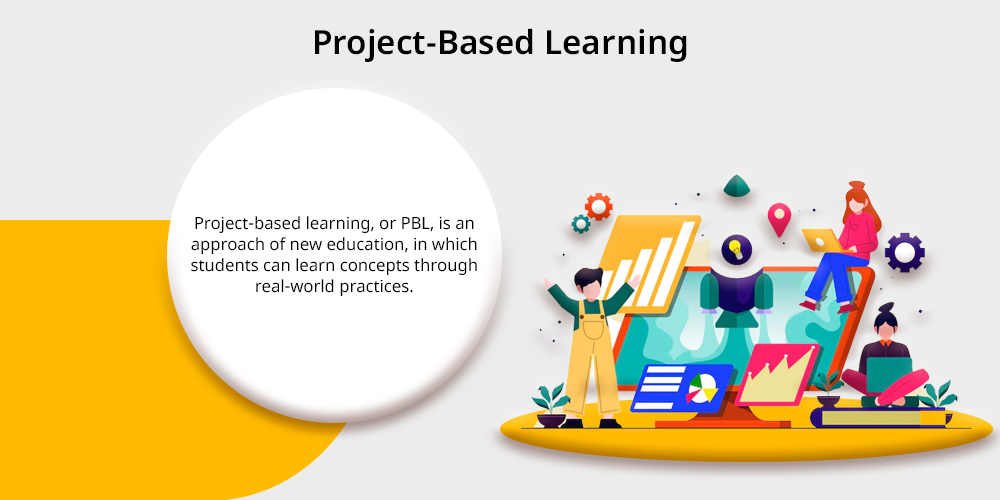
Project-based learning, or PBL, is an approach of new education, in which students can learn concepts through real-world practices.
PBL helps students to find solutions for challenges and boost mental abilities.
PBL also allows students to practice problem-solving ability through practical projects, which leads to the enhancement of creativity and teamwork. PBL includes site visits, practical presentations, activities and so on.
Conclusion
The landscape of online education has undergone significant change as a result of new teaching methods and technological advancements.
In addition to increasing accessibility and student engagement in the classroom, integrating technologies such as artificial intelligence (AI), augmented reality (AR/VR), microlearning, gamification, and mobile learning has also boosted students’ critical thinking, creativity and adaptability.
As we continue to embrace these innovations, online education appears to have a more effective and customized future that will meet a variety of needs and prepare students for potential obstacles in the real world.
Ultimately, online education’s ongoing evolution is a step toward a more dynamic and comprehensive teaching approach that ensures students have the skills necessary to thrive in a world that is changing all the time.



